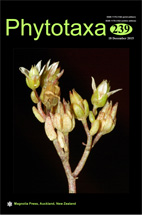Abstract
Clathrosporium retortum sp. nov., collected on submerged mixed leaf litter samples at Ilha do Cardoso State Park, São Paulo state, Brazil, is described based on morphological and molecular data. The fungus is characterized by forming whitish, dense, subglobose to irregular propagules, hyaline to subhyaline when young, subhyaline to dark brown at maturity, that are formed by densely interwoven conidial filaments with each conidial cell repeatedly branching bilaterally or occasionally unilaterally. Phylogenetic analyses using partial LSU nrDNA sequence data suggest that C. retortum belongs in the Sordariomycetes (Ascomycota) where it forms a well-supported clade with Clohesia corticola in the Sordariomycetidae, but its ordinal or familial placement remains unresolved. Its phylogenetic placement confirms the polyphyletic nature of aeroaquatic fungi like Clathrosporium, as it was distantly related to one available sequence in GenBank named as C. intricatum, the type species, which is phylogenetically related to the Helotiales (Leotiomycetes). However, due to lack of authenticity of the identity of this sequence with the type specimen of C. intricatum, a broad concept of Clathrosporium is tentatively adopted here to accommodate the present fungus instead of introducing a new genus. Beverwykella clathrata, Helicoön septatissimum and Peyronelina glomerulata are recorded for the first time from Brazil. Cancellidium applanatum and Candelabrum brocchiatum are new records for the state of São Paulo.

